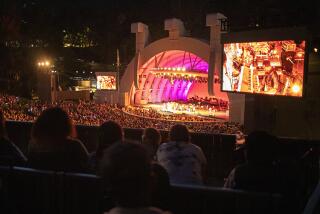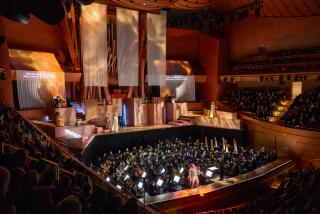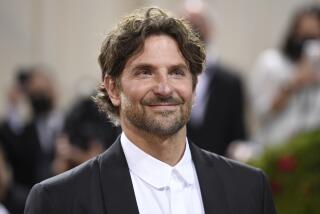Music review: Joshua Bell at the Hollywood Bowl
Bramwell Tovey conducted “Petrushka” at the Hollywood Bowl on Tuesday night. But before he did, the principal guest conductor of the Los Angeles Philharmonic for its summer concerts explained that Stravinsky kills off the eponymous puppet in his 1911 ballet by having a percussionist throw a tambourine down on a wooden table. Tovey said he had instructed a camera to pan to said tambourine and table at the appropriate moment so everyone would see them on the Bowl’s video screens.
What he may not have understood is that he also gave some in the audience their exit cues. The ballet score has yet more musically arresting moments to underscore the macabre marvel of a lifeless puppet returning from the dead to mock the living. But once tambourine hit wood, I noticed a surprising number of people making a quick getaway.
Making my own quick getaway once the performance ended, I saw why: Joshua Bell was the soloist in the first half of the concert, and he had agreed to autograph CDs at the end. The line was already long.
The program was dubbed by the Philharmonic “Joshua Bell à la Francaise” because the ever-youthful, ever-popular 40-year-old violinist from Bloomington, Ind., played two short, late 19th century French chestnuts. “Joshua Bell à la Joshua Bell” would have been closer to the mark.
Bell and the Bowl get along well. The chestnuts roasted were Chausson’s “Poème” and Saint-Saëns’ “Introduction and Rondo Capriccioso.” The first is 15 minutes of floating fin de siècle lyricism. The second is a lightweight showpiece with a knockout finish.
Bell played big. The sound system amplified him much and the orchestra less. The video cameras moved in close. A very powerful violin sound and a rapturous self-absorbed young man pervaded wide open spaces.
Bell’s playing was powerfully assured, emotionally charged and red-blooded. Chausson’s score can handle some of that vigor but not all of it.
Yet if he came across as something of a bull in a china shop, Bell was a fleet-footed one that didn’t break anything and so seemed very impressive. But one’s attention was drawn to the bull and not the superb china.
Saint-Saëns’ 10-minute piece, on the other hand, awards athleticism. Any music short of heavy metal can be borne down on too hard; still, the “Introduction and Rondo Capriccioso” is durable. Robust, fast and on-the-money, Bell here showed an all-American can-do spirit. He went for a standing ovation and got one.
His encore was a medley from the score John Corigliano wrote for “The Red Violin.” Bell played on the soundtrack, and he has participated with the composer in a small industry of spinoffs from the score. This one was but a two-minute solo, beginning with the film’s catchy theme and then moving on to fireworks. Here Bell took your breath away.
Tovey seemed to let the violinist be, but he made up for that in Berlioz’s Hungarian March from “The Damnation of Faust” to begin the program and “Petrushka” to end it.
The French connection was there in both pieces but not of primary interest. Maybe it took a Frenchman to write Berlioz’s kind of Hungarian music, but Tovey rightly emphasized its engaging Magyar swagger. “Petrushka” was created in Paris for Parisians, but Stravinsky was a homesick Russian émigré composing for Diaghilev’s Ballets Russes.
The Philharmonic eats Stravinsky for breakfast, and “Petrushka” is one of the nutrients the orchestra will take on its Asian tour with Esa-Pekka Salonen in October. Nevertheless, the score remains an obstacle course for any players.
The orchestra got through it relatively well. Tovey put his attention more on the dramatic character of the ballet and less on the composer’s revolutionary spirit -- this is a lead-up to “Rite of Spring.” With limited rehearsal and a Bowl full of Bell fans, that proved a reasonable strategy.
As he had with the violinist, Tovey allowed solo players in the orchestra to shine. Stravinsky all but turned certain passages into a piano concerto, so the most luster came where it was needed most -- from pianist Joanne Pearce Martin.
More to Read
The biggest entertainment stories
Get our big stories about Hollywood, film, television, music, arts, culture and more right in your inbox as soon as they publish.
You may occasionally receive promotional content from the Los Angeles Times.







